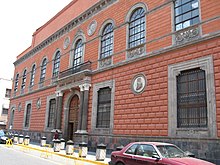Francesco Saverio Cavallari

Francesco Saverio Cavallari (born March 3, 1809 in Palermo , † 1896 in Syracuse ) was an Italian architect, painter and archaeologist in Sicily .
Life
As an autodidact, Cavallari learned the basics of painting and drawing from Giovanni Patricolo (1789–1861). After working with Domenico Lo Faso Pietrasanta , the Duke of Serradifalco (author of Le antichità di Sicilia e del duomo di Monreale e di altre chiese siculo-normanne , published in 1834 and 1838), he financed a degree in architecture in Rome .
Together with the German geologist Wolfgang Sartorius von Waltershausen (1809–1876) he worked out a relief map with the topography and geology of the Aetna . Through this contact he came to study in Göttingen , where he received his doctorate in archeology. Cavallari also had friendly ties to the German diplomat, antiquarian, art collector and founder of the Roman Instituto di Corrispondenza Archeologica, later the German Archaeological Institute , August Kestner , a drawing made by Cavallari (inv. No. Z. 1058), which is published today in Kestner had received from him as a present from the Kupferstichkabinett of the Landesmuseum Hannover .
Back in Sicily, Cavallari took an active part in the unrest of 1848. In 1854 he was appointed to the Accademia di Belle Arti di Brera in Milan , where he taught architecture.
The Austrian occupation forced him to leave Italy. In Mexico City he became director of the Academy of Fine Arts ( Academia de San Carlos ).
In 1864 he returned to Sicily, where he was appointed director of the island's collections of antiquities. In this role he led numerous excavations, including in Syracuse , Taormina , Agrigento , Gela , Solunto and Selinunt . Cavallari often involved the sculptor Valerio Villareale for the reconstruction work within the excavation sites .
In 1884 he was also appointed director of the Archaeological Museum of Syracuse. In Syracuse he also directed the restoration of several churches.
His most important work is the Topografia archeologica di Siracusa from 1883.
literature
- Giovanni Fatta, Maria Clara Ruggieri Tricoli: Un rinnovamento sulla base della natura: Serradifalco e l'unità dello stile, Cavallari e il connubio di tecnica ed arte. In: This: Palermo nell'Età del Ferro. Giada, Palermo 1983, pp. 88-92.
- Gabriella Cianciolo Cosentino: Francesco Saverio Cavallari. Caracol Verlag, Palermo 2007, ISBN 978-88-89440-21-6 .
Web links
- Francesco Saverio Cavallari ( Memento of November 4, 2012 in the Internet Archive ) in the Archivio biografico comunale.
- Meyers Konversationslexikon 1888
- Cavallari, Francesco Saverio. In: Enciclopedie on line. Istituto della Enciclopedia Italiana, Rome. Retrieved August 29, 2016.
| personal data | |
|---|---|
| SURNAME | Cavallari, Francesco Saverio |
| BRIEF DESCRIPTION | Italian architect, painter and archaeologist in Sicily |
| DATE OF BIRTH | March 3, 1809 |
| PLACE OF BIRTH | Palermo |
| DATE OF DEATH | 1896 |
| Place of death | Syracuse |